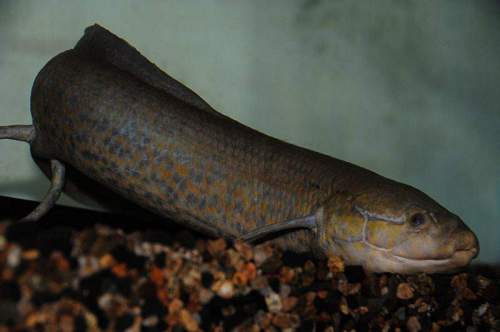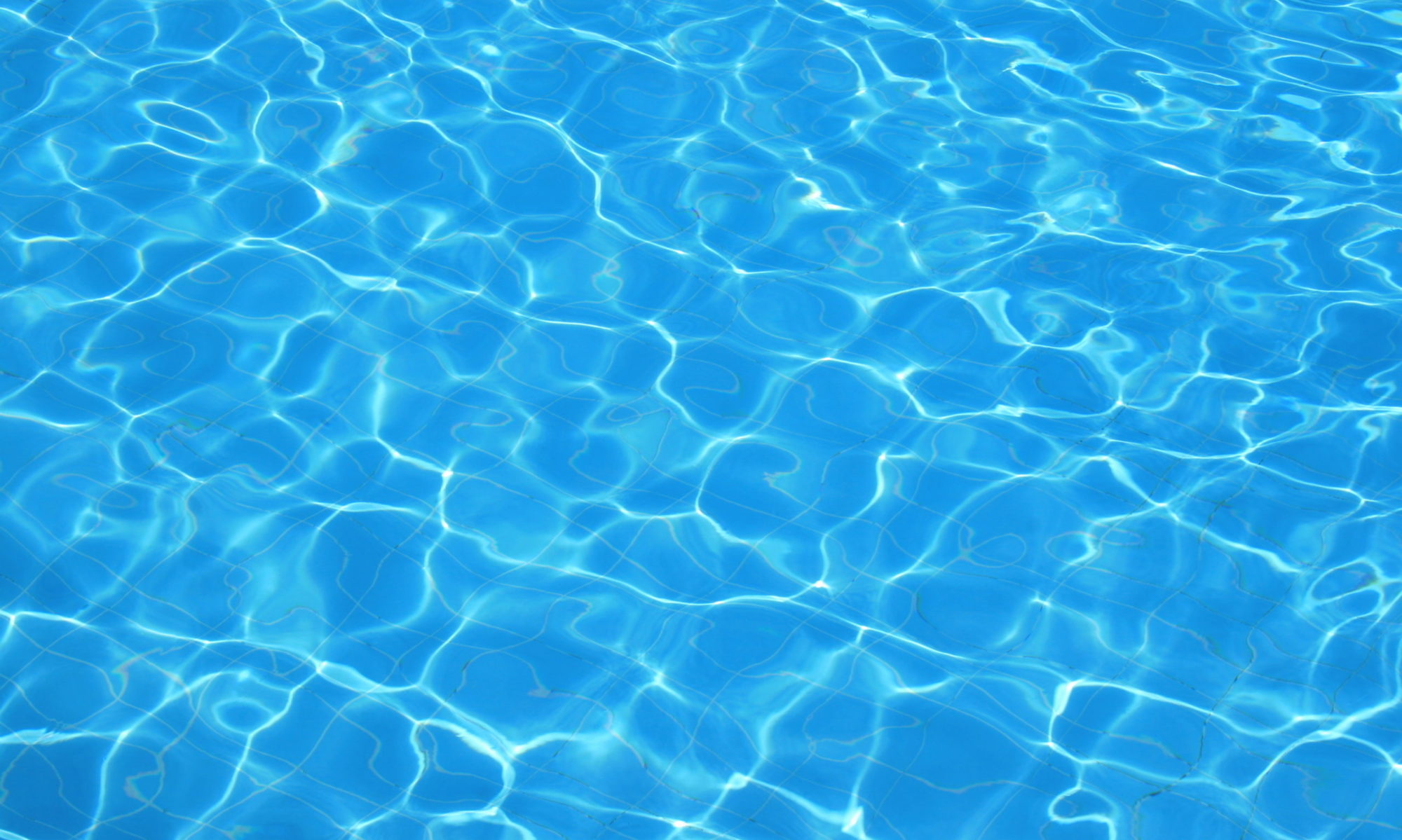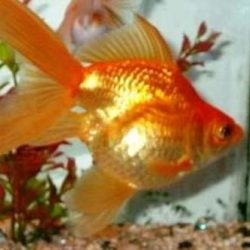Ornamental fish > Gilled African lungfish > West African lungfish – Protopterus annectens
The West African lungfish (Protopterus annectens) belongs to the Family Protopteridae (African lungfishes) in class Sarcopterygii (fleshy-finned fishes). These fish are also known as African lungfish, Lungfish, Mudfish and Tana lungfish.
The West African lungfish is native to the Niger River basin, Bandama River basin, Gambia River basin, Benue River basin, Mono River basin, Casamance River basin, Cross River basin, Comoé River basin, Congo River basin, Ouémé River basin, Senegal River basin and Kainji Lake.
The two recognized subspecies are: P. a. annectens and P. a. brieni (the upper Congo River area and from the Zambezi of Mozambique). The swim bladder in the West African lungfish has evolved into functional lungs as an adaptation to the seasonal drying up of their habitat.
These fish are obligate air-breathers. The lungs are the primary respiratory organs and the gills are also functional. Aestivation is another adaptation evolved by these lungfish to counter drying up of water bodies.
The West African lungfish making a hole, buries into the wet mud and secretes mucus to make a cocoon to withstand desiccation during long dry spells.
The West African lungfish hatchlings and young fish have true external gills and tadpole-like appearance. The young fish are completely dependent on the gills for respiration, till they develop lungs.
West African lungfish – Description
The West African lungfish has smooth, slimy, long, cylindrical, eel-like body tapering into pointed tail. It has a prominent snout. The head of West African lungfish has a conical profile with the mouth at the anterior end. The mouth can open widely to grasp, crush and swallow the food.
Eyes are very small and it is believed that the lungfish tracks its food more by smell-sense. The cycloid scales are deeply embedded. The dorsal side is olive or brown with blackish or brownish spots. The ventral side is relatively paler and is without spots.
The pectoral fins have loose skin at the base and are long, thin and fleshy. The pelvic fin is similar in appearance, but slightly shorter than the pectoral fin. The dorsal fin of West African lungfish originates on the middle of the back and merges with caudal fin.
Similarly, the anal fin originating behind the anal opening merges with the caudal fin. It has 34–37 pairs of ribs. Its premaxillary and maxillary bones are fused as in all lungfish to form heavily mineralized tooth-plates. The swim bladder has evolved into functional lungs and the gills have a reduced function.
Other behaviors and adaptations
Apart from the ability to breathe air, the West African lungfish have undergone several physiological modifications. When the water sources dry up, they undergo aestivation, a state of animal dormancy, characterized by inactivity and a lowered metabolic rate.
The West African lungfish burrow up to 20 inches into wet mud and make a chamber of mucus-mud. It actually chews through the mud, expelling it through the gill openings. It wriggles around to make a bulb like cavity and turns around to make the head face the opening.
It secretes slimy mucus around itself to make a cocoon. Under aquatic conditions, starving West lungfish can survive more than three and half years by entering the aestivated state.
Habitat and ecosystem
These lungfish are demersal, preferring to live in the bottom of the water body. Occasionally they come to the surface to gulp air. The West lungfish inhabit river and lake fringes, swamps, floodplains, pools, creeks, tributaries and mangroves with stagnant or slow flowing waters.
Such water bodies have very low dissolved oxygen and are likely to dry up in dry season. The ability to directly breathe air and the capacity for aestivation are the adaptations evolved by the West African lungfish for their survival in such conditions.

Distribution
The West African lungfish are widely distributed in Niger River basin, Bandama River basin, Gambia River basin, Benue River basin, Mono River basin, Casamance River basin, Cross River basin, Comoé River basin, Congo River basin, Ouémé River basin, Senegal River basin and Kainji Lake.
They are considered native to Benin, Burkina Faso, Cameroon, Central Afr. Rp, Chad, Cote d’Ivoire, Gambia, Ghana, Guinea, Mali, Niger, Nigeria, Senegal, Sierra Leone and Togo.
Reproduction and development
The mature West African lungfish spawn during rainy season. The male fish burrows and builds nest in weedy areas. After the release of eggs by one or several females, the male fish fertilize them.
The larvae hatch out in 8-10 days and leave the nest after 3-4 weeks. The male guards the eggs and the young lungfish and also aerates the nest by body and fin movements. They do not breed in captivity.

The hatchlings have thread-like external gills as in newts and resemble tadpoles. At this stage they can survive only with the dissolved oxygen in the water. After 2-3 months, the young west African lungfish develop lungs for air breathing.
Life span and size
The maximum recorded length of a wild West African lungfish is 40 inches (100 cm) and the weight is 4.0 kg. These fish can live up to twenty years in natural conditions.
Diet and feeding habits
Juvenile fish feed on aquatic insects, their larvae and also fry of fish. The adult West lungfish is carnivorous, feeds on fish, mollusks, shrimps and large aquatic insects. Sometimes it may also take detritus and algal matter.
Conservation status
IUCN Red List status has evaluated and listed these West African lungfish as of ‘Least Concern’ (LC).
West African lungfish aquarium
To accommodate such long-living, lungfish we may require an aquarium of at least 100 gallon capacity. In the aquarium they may be fed with pieces of meat especially fish meat. They may very reluctantly eat pellet and formulated feed. Hand feeding must be avoided as they may give a nasty bite.
The tank must have lot of space for movement and also have some hiding spots. The water must be exchanged often to remove the waste materials from such protein food as the water can get polluted easily. Please go to pages on quick facts and Protopterus annectens aquarium for further information.
Reference: https://www.fishbase.org/summary/Protopterus-annectens
1.Image source: https://en.wikipedia.org/wiki/File:G%C5%91tehal-2.jpg
Image author: Mathae | License: CC BY-SA 3.0
2.Image source: https://commons.wikimedia.org/wiki/File:Annectens.jpg
Image author: Takada@mex | License: CC BY-SA 3.0
Current topic in Aquarium fish pictures: West African lungfish – Protopterus annectens.

